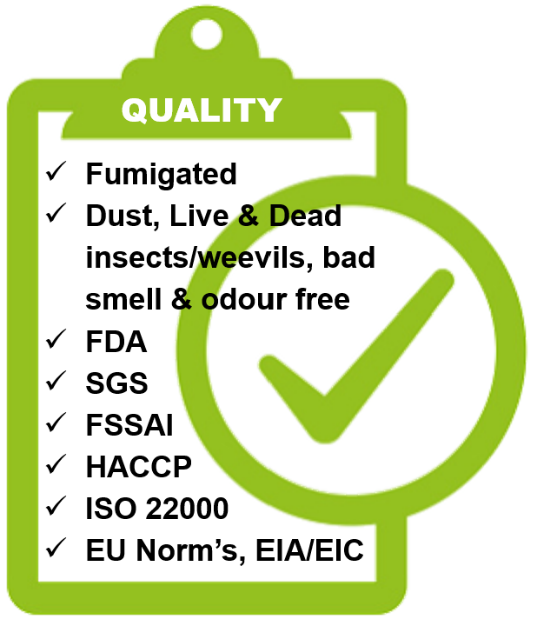Products
Food Safety and Standards (Fortification of Foods) Regulation 2016
FSSAI STANDARDS FOR FORTIFICATION OF RICE
Rice, when fortified, shell contain added iron, folic acid and vitamin B-12 at level given in the table below:
In additional, it may also be fortified with following micronutrients, singly or in combination, at the level given in the table below:
Fortifying Rice
Rice fortified with the fortificant mix by dusting; or coated or extruded fortified kernels mixed with non-fortified rice in a ratio varying between 0.5%-2% is fortified rice.
Rice fortification is a cost effective, culturally appropriate strategy to address micronutrient deficiency in countries with high per capita rice consumption. India is a leading rice producing country, with 22% of the total global rice production and 65% of India’s population consumes rice on a daily basis. The per capita rice consumption in India is 6.8 kilogram per month. Fortification of rice makes it more nutritious by adding vitamins and minerals, many of which are lost during the milling and polishing process.
Rice can be fortified using dusting, coating or extrusion technology. Extrusion is the preferred technology for rice fortification given the stability of micronutrients in the rice kernels across processing, storage, washing and cooking, also in view of cost considerations.
In extrusion technology, milled rice is pulverized and mixed with a premix containing vitamins and minerals. Fortified rice kernels (FRK) are produced from this mixture using an extruder machine. The kernels resemble rice grains. FRK is added to non-fortified rice in ratio ranging from 1:50 to 1:200 resulting in fortified rice nearly identical to traditional rice in aroma, taste, and texture. It is then distributed for regular consumption.
The cost of fortification is determined by a multitude of context specific variables such as the structure and capacity of the rice industry, the complexity of the supply chain, the policy and regulatory environment and the scale of the relevant programme.
Rice is dust, live & dead insect/ weevils, bad smell & odour free. All standards are as per APEDA, FSSAI and international food & Safety approved norms.
General Packing: In new single white woven polypropylene bags, each of 50kg net shipped weight, with buyer’s marks. Minimum tare weight of 110g. 2% empty bags to be loaded at the seller’s cost.
Pre shipment Inspections: Current crop. Weight, quality, and fumigation are final at loading as per certificates issued by a First-Class Superintendent Company
Insurance: for the buyer’s account
Shipment period: 15 – 45 days after publication date
Documentation: Standard shipping documents.

Payment: 30% advance on confirmation of order against acceptance of proforma invoice and balance 70% immediate on mail of shipping documents.

